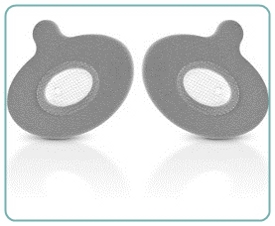Provent- A New Sleep Apnea Treatment
 Approved by the Food and Drug Administration in 2008, Provent has spread mostly by word of mouth. But it has caught on fast. Its manufacturer, Ventus Medical, says it has shipped one million of the devices in the past 12 months, up from a half million total in the two years prior. Doctors say it has given them a new weapon in the battle against sleep apnea, and many patients who struggled with CPAP call it a godsend.
Approved by the Food and Drug Administration in 2008, Provent has spread mostly by word of mouth. But it has caught on fast. Its manufacturer, Ventus Medical, says it has shipped one million of the devices in the past 12 months, up from a half million total in the two years prior. Doctors say it has given them a new weapon in the battle against sleep apnea, and many patients who struggled with CPAP call it a godsend.Bob Bleck, who owns a computer networking firm in Ohio, struggled with poor sleep and chronic fatigue for decades. But it was only a year and a half ago that he finally went to a sleep clinic, prodded by his wife, who worried about his heavy snoring.
The diagnosis was severe sleep apnea. Tests showed that in a typical night, Mr. Bleck, 47, awoke or stopped breathing 42 times an hour.
“After I started using it, I noticed a difference right away,” he said. “My symptoms subsided dramatically.”
Provent works like a traditional CPAP machine but is only a fraction of the size. When people with apnea fall asleep, their throat muscles collapse, constricting the airway and causing the body to fight for air. CPAP machines use mild air pressure to keep the airway from constricting.
Provent does too, but in a different way. The device contains two pinhole-size valves, one over each nostril. The valves let air in easily — most people breathe through their nostrils while asleep — but there is resistance as the user exhales. That resistance creates a backpressure in the airways, dilating the muscles that would otherwise collapse in the middle of the night. In the morning, the patch is removed; a new one is used every night.
Last year, in a large study of 250 apnea sufferers published in the medical journal Sleep and subsidized by Ventus, researchers found that those who used Provent devices over a three-month period saw their apnea episodes fall sharply, compared with people who were given a sham, or placebo, device. A follow-up study tracked people over the course of a year and had similar results.
Unlike CPAP, Provent is not covered by Medicare and most major insurers, though some doctors say they expect that will change in the near future. In the meantime, a 30-day supply of the patches costs $65 to $80.
For now, CPAP will continue to be the gold standard, and certainly the first option for patients with severe apnea. But for the roughly 50 percent of patients in whom CPAP fails, Provent may be a reliable alternative.
[Excerpts taken from Well: The New York Times Health/Science Blog. To Treat Sleep Apnea Without the Mask by Anahad O'Connor. Click here to read the entire story.]

Source: O'Connor, Anahad. (April 9, 2012). To Treat Sleep Apnea Without the Mask. Well: The New York Times Health/Science Blog. Retrieved October 16, 2012 from http://well.blogs.nytimes.com/2012/04/09/treating-sleep-apnea-without-the-mask/
Comments
Display comments as Linear | Threaded